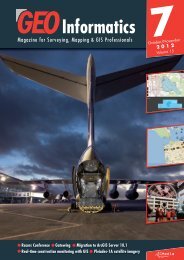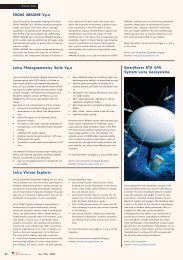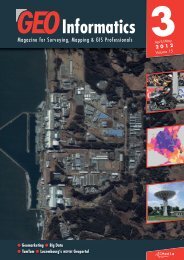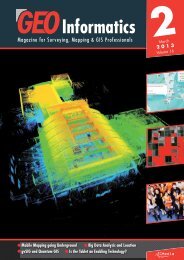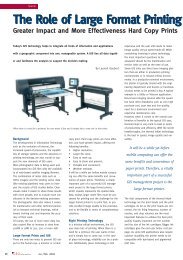2013 - Geoinformatics
2013 - Geoinformatics
2013 - Geoinformatics
Create successful ePaper yourself
Turn your PDF publications into a flip-book with our unique Google optimized e-Paper software.
32<br />
A r t i c l e<br />
Patagonia National Park<br />
By Rick Tingey and<br />
John Timar<br />
Conservacion Patagonia and its partner organization Round River Conservation<br />
Studies needed to create a comprehensive map of the Patagonia National Park,<br />
a 650,000-acre expanse of mountains, grasslands, forests, wetlands, rivers and<br />
alpine lakes located in Chile’s Aysen Region. With numerous independent<br />
scientific researchers uncovering new information about the landscape, the organizations<br />
needed a shareable system for recording data about the region in a<br />
geospatial context. They turned to a geospatial collaboration software solution<br />
which finally yielded a rich and detailed information base that any collaborator<br />
and view and edit.<br />
Preserving Patagonia National Park<br />
U s i n g G e o s p a t i a l C o l l a b o r a t i o n S o l u t i o n s<br />
With a commitment to the<br />
wild future of Patagonia,<br />
a region located at the<br />
southern end of South<br />
America, Conservacion<br />
Patagonica is an organization that works to<br />
create national parks that save and restore<br />
wildlands and wildlife, inspire care for the natural<br />
world, and generate healthy economic<br />
opportunities for local communities.<br />
Created by Conservacion Patagonica, the<br />
future Patagonia National Park is a 650,000-<br />
acre expanse of mountains, grasslands,<br />
forests, wetlands, rivers and alpine lakes located<br />
in Chile’s Aysen Region. When<br />
Conservacion Patagonica began the<br />
Patagonia National Park project, it set off into<br />
uncharted territory to create comprehensive<br />
and functional maps of the landscape.<br />
Through its partner organization Round River<br />
Conservation Studies, which provides student<br />
study abroad programs and extensive field<br />
research and community planning, the organizations<br />
needed to generate baseline mapping<br />
data about wildlife and plants in<br />
Patagonia National Park. The organization<br />
found that while government survey maps provided<br />
an accurate rendering of the terrain,<br />
they did not offer collaboration and data customization<br />
capabilities. In addition, Web map<br />
services could only provide so much in a<br />
region where Internet connectivity is scarce.<br />
Collaboration and information sharing<br />
With numerous independent scientific<br />
researchers uncovering new information about<br />
the landscape, the project required a shared<br />
and shareable system for recording place<br />
data. As such, Round River Conser vation<br />
Studies set out to create a platform that encouraged<br />
and supported collaboration and information-sharing<br />
among the various people<br />
working on the ground in the park: the wildlife<br />
recovery team, independent scientists, the trail<br />
building team, historians and archeologists<br />
and others.<br />
Round River Conservation Studies needed the<br />
right geospatial collaboration solution to help<br />
create a central repository for all work that is<br />
being done in the region, and that could be<br />
shared with the larger scientific community<br />
and beyond. More importantly, the solution<br />
needed to be easy to manage, update and<br />
ultimately, enable everyone on the team share<br />
this data.<br />
The organization turned to TerraGo’s geospatial<br />
collaboration software for creating cus-<br />
June <strong>2013</strong>





